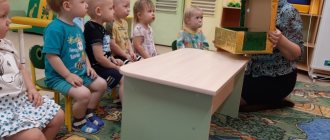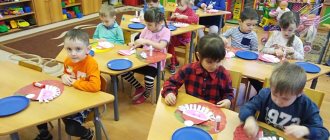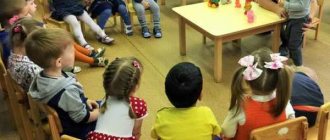Speech development in the middle group of preschool educational institutions
The development of communication and speech skills, which includes enriching vocabulary and developing clear pronunciation, is considered one of the main tasks for preschoolers.
Note! For the correct speech development of children in the middle group, educators do a tremendous amount of work. It is based on a set of special exercises and methodological techniques aimed at improving speech skills and developing a high culture and politeness of speech.
To develop speech in the middle group of preschool educational institutions, various directions are used:
- children’s knowledge and ideas about surrounding objects deepen;
- children become familiar with the details and names of parts of things;
- words denoting the properties of objects and phenomena are studied;
- vocabulary in the field of professions is replenished;
- words that denote relationships between people are studied;
- children learn to express their own thoughts in complex sentences that are grammatically correct.
To solve the assigned tasks in the middle group, the teacher must take a responsible approach to the process and purposefully conduct classes.
Federal State Educational Standards requirements for speech development
All educational institutions, regardless of whether they are public or private, must focus on certain program requirements that are specified in the Federal State Educational Standard.
As for the speech development of preschoolers, the requirements are as follows:
- Vocabulary must be constantly enriched;
- the child must have speech skills in accordance with age;
- the sound and intonation range of speech expressiveness should expand;
- develop the ability to perceive sounds by ear and at the same time hear, identify and, if there are errors, correct them;
- develop the ability to listen and remember the storyline;
- develop logically consistent and meaningful speech;
- skills of retelling and acting out dialogues;
- the child must learn to convey the meaning emotionally and read a poem by heart with expressiveness;
- work should be carried out to expand the horizons of preschoolers about objects, properties, phenomena and the concept of a coordinate system;
- generalizing concepts are introduced into the lexicon;
- training is provided to improve the grammatical construction of sentences.
Note! All training sessions should be conducted by the teacher so that they simultaneously include solving assigned problems and game moments. Only in this case will it be possible to interest children and achieve the desired results.
Age-related psychological characteristics of children in the middle group of preschool educational institutions
In terms of development, middle preschool age is a continuation of early childhood. During this period, children master the world of permanent things, master the culture of speech, and the formation and development of psychological perception also occurs.
In middle age, children continue to actively develop speech, substitution ability, thinking and imagination. With the help of speech, middle group students express their emotions and share their impressions.
Note! There is a rapid development of memorizing information and retaining it in memory, and the ability to concentrate is also enhanced.
As a rule, at this age, kindergarten teachers conduct special planned classes on speech development. They are provided for by special educational standards. But, despite this, pedagogical work in this direction is not limited to a certain framework. The most important thing is that when selecting tools, the teacher must take into account all the age characteristics of his students.
Methodological tools
Within the framework of the requirements of speech development, the teacher faces serious tasks that force him to approach the process thoughtfully, responsibly and in accordance with certain standards.
Basic pedagogical techniques
Each lesson on speech development in the middle group should be based on a specific pedagogical technique. Currently, three main groups of speech development techniques in preschool institutions have been identified. These are verbal, visual and playful techniques.
Their essence is as follows:
- Teaching stories using story pictures.
- Daily reading of fiction, which is provided for in the educational program.
- Carrying out work with children in a conversation format.
- Application of gaming technologies.
- Systematic and unobtrusive repetition of a new word.
- Motivation to complete the curriculum.
Note! In addition to implementing the pedagogical techniques listed above, the teacher must organize physical education sessions for students. They are also part of the curriculum and help to develop a serious attitude towards physical education in children.
Games for speech development
By the age of five, children should learn to pronounce all sounds correctly. You can achieve your goal through daily breathing exercises.
You can form grammatically correct speech thanks to games and exercises:
- "More less".
- “Call me kindly.”
- “Whose toy?”
- “Continue the sentence.”
- "Which".
Speech corner equipment
In order to stimulate independence and informal playful communication with children, in accordance with the requirements of the Federal State Educational Standard, an aesthetically attractive, comfortable and special subject-development environment must be created in which children will not be afraid, but rather feel at ease and at ease.
Important! It is best to place the speech corner away from the playing area in a well-lit place. It must be equipped with didactic and visual aids, as well as the necessary materials that are used by the teacher during classes.
Table: filling out the speech corner by section
| Chapter | Content |
| Certificate | Schemes of words, sentences and corresponding games (“Add a word”, “Choose a word”), puzzles and crosswords. |
| Connected speech | Subject pictures, “Playing in the profession”, “Guess by the description”. |
| Grammar | Games “Name it affectionately”, “One-many”. |
| Vocabulary | Pictures, lotto, puzzles. |
| Sound pronunciation | Game exercises, games to automate sounds. |
| Breath | Pipes, bubbles, balloons for inflation. |
| Fine motor skills | Pencils, puzzles, mosaics, tops. |
| Phonetic hearing | Sound differentiation games. |
| Articulation gymnastics | Pictures, sets of exercises, methodological literature. |
| Higher mental functions | Dominoes, cut pictures. |
Note! Among other things, experts recommend having Ushakova’s book “Speech Development” in the speech corner. It examines in detail all the problems of speech development for children in the middle group, selects methodological recommendations and compiles lesson notes.
Federal State Educational Standards requirements for speech development
In 2013, our country adopted the Federal State Educational Standard, a special educational standard, on the basis of which kindergarten teachers develop educational programs for preschoolers. The Federal State Educational Standard consists of requirements based on the results of mastering educational programs. According to them, speech development in the middle group of kindergarten includes the following components:
- Its formation is at the level necessary to establish contacts with adults and children of different ages.
- Expanding vocabulary.
- Developing the ability to construct dialogues and conduct a monologue.
- Development of speech creativity, i.e. the ability to compose a story or come up with a poem.
- Reading books, improving reading comprehension skills.
- The ability to separate words into individual sounds and combine sounds into words.
- Mastering the principles of pronunciation and stress in words, the ability to expressive speech.
Lesson on speech development in the middle group
Planning lessons should be carried out according to methodological recommendations.
Lesson structure
Each lesson should be conducted according to a specific scheme:
- The organizational introductory part is characterized by a motivating and stimulating nature. The main task of the teacher at this stage is to get the children into the mood for work and awaken their interest in the topic.
- Practical part - the teacher sets the tasks and explains the essence of the task.
- Active work - children complete tasks in conjunction with a verbal assessment of the students’ activities.
- Summing up - the teacher’s goal is to draw children’s attention to the result.
Age-related psychological characteristics of middle group children
Children 4-5 years old are more active, their emotionally charged activities become a way of psychological release, but, most importantly, they begin to experience an urgent need to communicate with peers. If previously a child could calmly be in the company of toys, books or cartoons, now he wants to talk and do it a lot and for a long time. That is why in the middle group of a kindergarten a developing speech environment should be created and classes should be conducted that will stimulate speech. However, for the most part, children's speech develops through their interactions with each other. Also, new features appear in the interaction of preschoolers with teachers; they begin to strive for cognitive, intellectual communication. It is at this moment that it is important to begin developing a culture of verbal communication, to set a speech example for children. During this period, you cannot brush off the child’s questions or answer with irritation or reluctance.
Valentina Gerbova
Classes on speech development in the middle group of kindergarten
Lesson Plans
Library “Programs of education and training in kindergarten” under the general editorship of M.A. Vasilyeva, T.S. Komarova, V.V. Herbovaya
Gerbova Valentina Viktorovna – Candidate of Pedagogical Sciences, author of manuals on methods of developing children’s speech and introducing them to fiction.
From the author
The successful implementation of program objectives depends on a number of factors and, above all, on the way of life of a preschool institution, the atmosphere in which the child is raised, and on a specially designed, thoughtful developmental environment.
The effectiveness of education and training is achieved through the painstaking work of teachers who work directly with children and all preschool employees who communicate with preschoolers during the day.
The system of work on teaching children their native language, introducing them to fiction is presented in the works of V. V. Gerbova “Development of speech in kindergarten”, “Introducing children to fiction” (M.: Mozaika-Sintez, 2005).
The manual “Classes on speech development in the middle group of kindergarten”, written as part of the “Program of education and training in kindergarten” edited by M.A. Vasilyeva, V.V. Gerbova, T.S. Komarova, supplements recommendations on the most important area of pedagogical activity - targeted and systematic training of preschoolers in the classroom. The practical purpose of the book is to provide educators with approximate guidelines for planning lessons (defining topics and learning goals, ways to implement them).
Features of speech development in children of the fifth year of life
In the middle group, intensive work is provided to deepen children's knowledge about various subjects. The passive and active vocabulary of preschoolers is enriched by words - names of parts and details of objects, their qualities and properties (color, shape, size, texture, etc.), as well as concepts characterizing spatial and temporal relationships.
Children are taught to use generalizing words in speech, for example: clothes, shoes, furniture, dishes, vegetables, fruits, flowers, birds, animals.
; group familiar objects and classify them (dishes: tea, table, kitchen; shoes: summer and winter).
The vocabulary of preschoolers is replenished with words that reflect relationships between people.
Children begin to use the names of military professions in speech: sailors, border guards, pilots
etc.
By mastering the vocabulary of a language, children also master its grammatical structure. In the fifth year of life, preschoolers begin to master the methods of forming nouns with suffixes of emotional-expressive evaluation, nouns denoting young animals, as well as some methods of forming verbs with prefixes and degrees of comparison of adjectives.
In the speech of children of this age, simple common sentences predominate. The number of common sentences with homogeneous members (additions, definitions) is increasing. Sentences with homogeneous circumstances appear.
Four-year-old children use complex sentences relatively freely, both without conjunctions and with conjunctions a, and
, as well as complex sentences (usually with additional and subordinate clauses). The number of complex sentences with subordinate clauses is increasing.
At the same time, expressing detailed judgments and at the same time following the progress of their thoughts, children find it difficult to simultaneously monitor the grammatical form of their presentation. This is evidenced by errors in the coordination of words in a sentence, omissions of individual members, and difficulties in constructing simple sentences that are part of a complex one.
The program provides for teaching children of the fifth year of life the ability to use grammatically correct forms of words, in answers and stories to express their thoughts in complete sentences, the meaning of which is understandable to others. Solving these problems requires systematic, purposeful work of the teacher.
The requirements of the program for teaching four-year-old children conversational (dialogical) speech come down to developing their ability to listen and understand speech addressed to them, participate in a collective conversation, answer and ask questions. At the same time, it is necessary to instill in preschoolers sociability, tact, and restraint - qualities necessary for a person to communicate with others.
The teacher must teach children to answer questions clearly and meaningfully, while trying not to disrupt the liveliness and emotionality of speech, its originality. However, the content of a child’s speech, the completeness and consistency of statements is determined by the richness of his vocabulary and the degree of mastery of the grammatical means of the language. Therefore, the development of coherent speech should be carried out in conjunction with the formation of a vocabulary and grammatically correct speech.
Federal State Educational Standard (FSES) for preschool education
To improve the quality and effectiveness of education and ensure the full development of children, a special standard of the Federal State Educational Standard is used. It includes a list of requirements for the effectiveness of the Preschool Education Program, its size and the conditions for implementation. Based on the Federal State Educational Standard, a Training Program and related standards (costs, financial support, employee certification) were created.
The foundation for the development of the standard was the Constitution of the Russian Federation, the legislation of the Russian Federation and the UN Convention on the Rights of the Child. For institutions or individual entrepreneurs whose work is to provide educational services, the Federal State Educational Standard is a mandatory component.
The Federal State Educational Standard has defined the criteria for speech acquisition in children:
- Expanding vocabulary.
- Acquisition of speech skills as a method of communication and culture.
- Improving sound and intonation speech, the ability to correctly hear sounds and recognize them.
- Listening to children's works.
- Coherent speech, grammatically correct dialogues and monologues.
Speech acquisition is a complex and mysterious process from the point of view of child psychology and pedagogy. Speech development is the consistent and purposeful work of teachers. Special teaching methods and the child’s own exercises are used to stimulate speech improvement.




